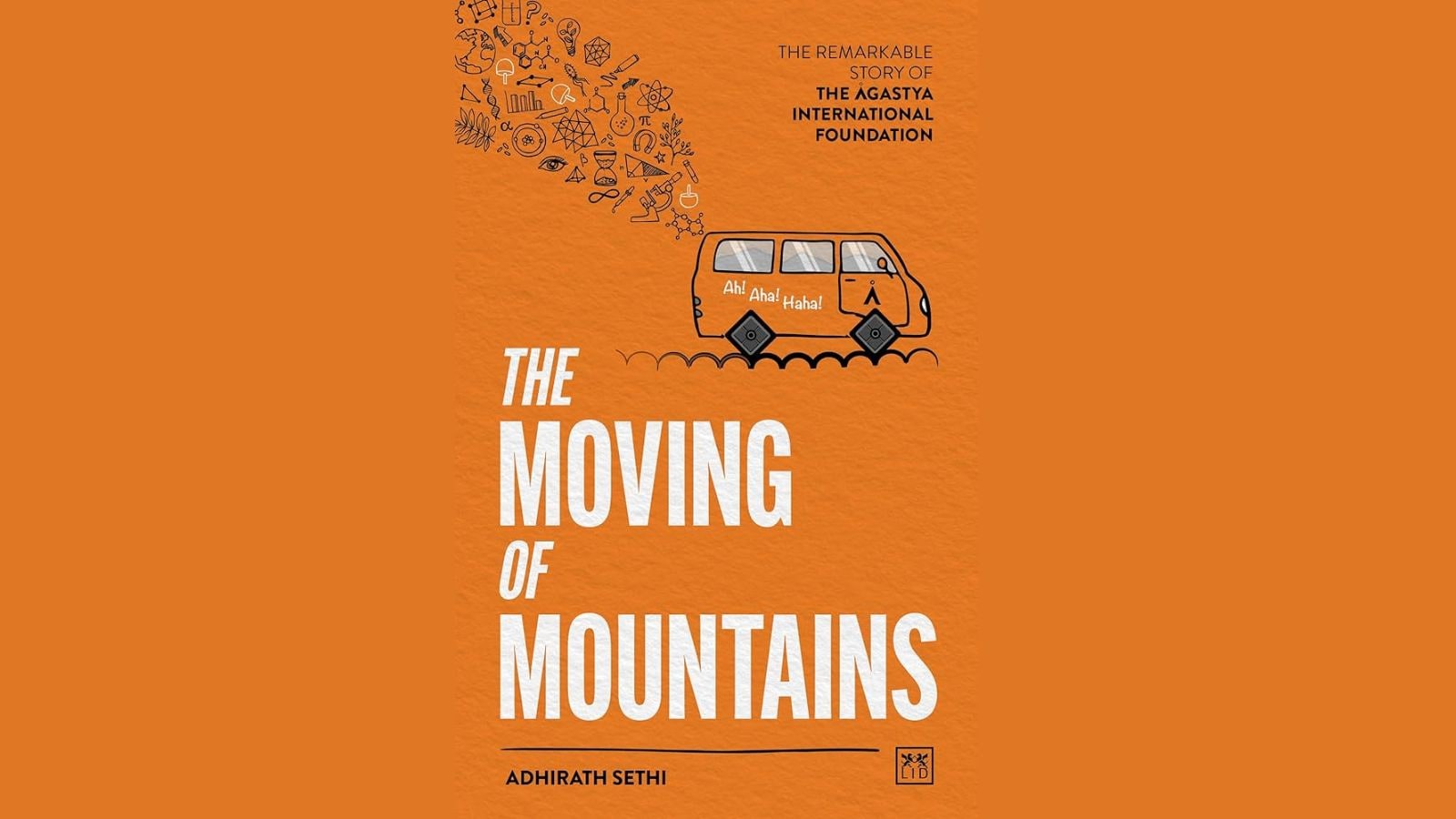Book Extract | ‘The Moving of Mountains’: Recounting A Kalam Story

The book, Moving of Mountains: The Story of the Agastya International Foundation, by Adhirath Sethi is an inspiring book about a 25-year journey to improve education in India. It shares how science was brought to remote areas and how spaces were created for poor children to explore, question, and create. Agastya’s work was featured last year in a popular Netflix show at its Mumbai Science Centre. One particularly compelling story is that of Jhunjhunwala, who began a meeting with Agastya’s Ramjee disinterested, but was so moved that he eventually invested Rs 50 crore to help revolutionise the education system. The following is an extract from the book: On a blindingly bright day in the summer of 2012, the mood on the Agastya campus was considerably more electric than usual. The preceding five years had seen new buildings brought to life, including the Jhunjhunwala Discovery Centre, a planetarium, and a host of other labs and accommodation. With this infrastructure, the campus was able to welcome around 500 children from surrounding schools each day. Hence, it was not unusual to see and hear groups of children animatedly chatting and running around, clearly enthused by their day on campus. But this particular day was different. All in all, a few thousand children and scores of their teachers flocked to the Agastya campus eager to catch a glimpse of the iconic man whose visit had been announced a few weeks ago. Ramji’s first meeting with Dr A.P.J. Abdul Kalam happened in 2003, when Dr Kalam was still president of India. The introduction had been made via scientists who had worked with Kalam in the past and were now friends of Agastya. These included Dr R. Krishnan and K. Ramchand, who had heard Ramji speak at a seminar at the National Institute of Advanced Studies in 2001 and had subsequently invited him over for dinner. The connection was further strengthened by Dr Aatre, who had succeeded Dr Kalam as the head of the Defence Research and Development Organisation. ‘My first meeting with Dr Kalam took place at his office at Rashtrapati Bhavan, the presidential palace in Delhi,’ Ramji recalls. ‘Dr Kalam questioned me about my plans. Why had I returned to India? What did I hope to achieve? He was keen to know about the mobile science lab that we had launched less than six months ago in Gudupalle. What science experiments did the lab carry? How many children could it reach? Who was the teacher, how was he trained and by whom? For an iconic president, Dr Kalam had a friendly and easy manner. As he listened closely to my answers, he would count the worry beads in his hand. He leaned forward at one point and said that the problem with most leaders in India was that they were interested only in working from a comfortable office in the city. “Very few people want to go out to the field. If you want to make a difference, go to rural India.” I asked Dr Kalam what he felt the country needed most. “Three things,” he said. “Curiosity, skills and confidence.” As I bade him goodbye, Dr Kalam wished me success and said he would like to visit Agastya someday.’ Given Kalam’s hectic schedule, Agastya would not have a chance to showcase its work to the president for another three years. On a visit to Bangalore in 2006, Kalam asked to see the Agastya mobile science lab. He spent time reviewing the experiments and talking to the children who had gathered. He even posed for a photo in front of the mobile lab. To the unruly throng of reporters that was throwing a volley of questions at him on India’s social challenges, he said, ‘Why don’t you write about Agastya’s positive work?’ As he got into his car to leave, he turned to Ramji and said, ‘I will help you if you decide to expand your mobile labs into India’s backward areas in the north.’ Kalam believed that most organizations were satisfied to work in and around urban areas, where connectivity was good, and staff were easier to hire. However, in many of India’s poorest states, there were areas that remained completely ignored. He wanted Agastya to reach into these parts, believing that children there would truly benefit from exposure to Agastya’s methods. True enough, a few years later as Ramji was boarding a flight, he received a call from Kalam. Kalam had been awarded the S.R. Jindal Prize for exemplary service to humankind. Ramji congratulated Kalam on his winning the prize. Kalam laughed and replied that he wasn’t calling to be congratulated but rather to deliver some good news. The prize carried a cash reward of Rs 1 crore ($150,000) and Kalam had decided to split this between four NGOs. He intended to give one of these portions to Agastya to buy two mobile science labs to serve the poorest children in the remotest areas of Bihar. In 2012, Kalam’s long-awaited trip to the Agastya campus was finally planned. Ramji remembers being called to meet him at the Raj Bhavan in Bangalore, at midnight, the night before Kalam was set to visit the Agastya campus. ‘At eighty, looking remarkably fresh at the late hour, he listened to my update on the Bihar mobile lab programme, enquired about the following day’s schedule and expressed his eagerness to help Agastya in any way he could,’ Ramji recalls. Kalam’s visit to the campus was truly a sight to behold. As he marched through the campus, the army of children followed him like a million flecks of iron stringing behind a powerful magnet. The noise level was incredible, and the thundering of young, eager feet churned the land’s light, chalky earth into an enormous pale cloud of fine dust. When Kalam took to the podium to give his speech, the rousing crowd cheered him like he was a rock star. His talk and stimulating presence at the Agastya campus left a lasting impact on many underprivileged children. The same day, he would inaugurate Agastya’s newest building: VisionWorks, the model-making workshop that Agastya had envisioned nearly a decade ago when building its discovery centre. It was on Kalam’s insistence that Agastya launched a mega- science fair in Darbhanga, Bihar, later that year. A deeply compassionate man, Kalam felt genuine concern that certain poorer pockets of India—Bihar in particular—were being left behind by the progress that was washing over the rest of the country. Kota Harinarayana, who had worked with Kalam and later managed the latter’s Viksit Bharat Foundation, recalls the passion that Kalam felt for the state of Bihar. ‘We wanted to improve the education levels in Bihar,’ he explains. ‘One of the major vehicles for Dr Kalam was science education through the mobile science labs. Agastya trained the people there and implemented the programme. Dr Kalam felt that Agastya was one place where the students were experimenting with their hands; that there was so much energy in the work Agastya was doing. Dr Kalam was very deeply appreciative of Agastya. He used to hear about Agastya from me and Dr Krishnan. He knew all the work that they were doing, and he was keenly aware of the positive impact of the mobile labs in Bihar.’ Kalam’s connection with children was indeed remarkable. One Diwali, Ramji remembers visiting Kalam’s Rajaji Marg home office in Delhi with his 17-year-old daughter, Jeena. Visibly elated by Jeena’s presence, Kalam asked her, ‘What is your passion?’ ‘Painting,’ she replied. (Jeena would go on to earn a degree in fine arts from the prestigious Parsons School of Design in New York). ‘How wonderful,’ he beamed and followed up with his next question, ‘What is the first thought that comes into your mind when you paint?’ She thought for a moment and said, ‘Colour.’ ‘Aha!’ he said with delight, as if she had solved a puzzle. Much later, as they rose to leave, Kalam asked an assistant to fetch a book from his library. He walked Ramji and Jeena out into the cool night. Under the lights outside, he softly read out words of wisdom from his book of poems to Jeena like a grandfather reading to his favourite granddaughter, and asked her to repeat the words after him. He pointed to the dark silhouette of a large tree in his garden. ‘That tree is called Arjuna,’ he explained. ‘It is 500 years old.’ Ramji could not help but be struck by this remarkable man who, against all odds, had risen to the highest office of the land. For a few precious minutes this famous scientist—the son of a poor boatman—had made a young girl feel as if she was the most special person on earth. As Kalam and Ramji made their way through the mist on a cold winter’s day in distant Darbhanga to inaugurate the Agastya mega-science fair in Bihar, Ramji asked him to reveal the secret of his almost limitless energy. Without the slimmest shade of pretence, Kalam replied, ‘When you give selflessly, you gain energy.’ Dr Kalam’s involvement with Agastya was yet another endorsement that launched the foundation’s image and reputation onto the national stage. His belief that Agastya’s approach could bring about a mass transformation was a validation that infused new energy into the foundation and allowed it to push forward with even more gusto and aplomb. The book, ‘Moving of Mountains: The Story of the Agastya International Foundation’, is written by Adhirath Sethi. Views expressed in the above piece are personal and solely those of the author. They do not necessarily reflect News18’s views.



















